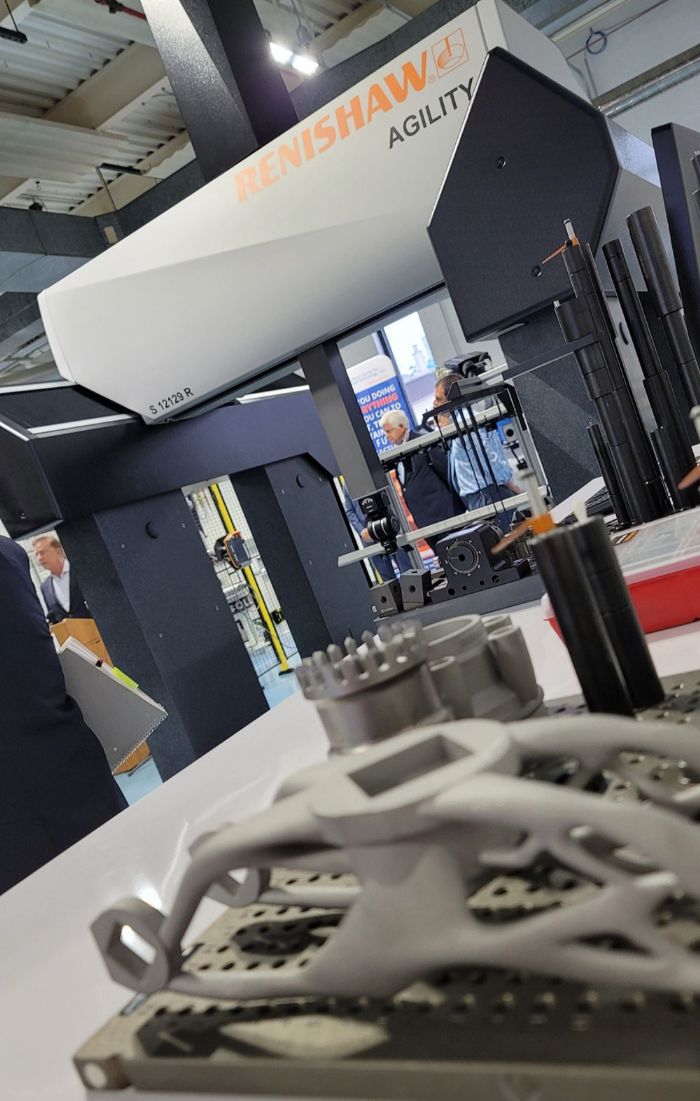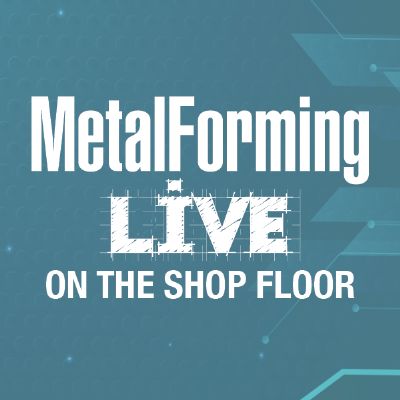James DeMuth, co-founder and CEO of Seurat Technologies, will unpack the realities of all of this and explain how, for the first time, AM can be cost-competitive with traditional fabrication and enable an attractive environment for reshoring in every way.
Solid State 3D Printing for Aerospace; Large-Scale Metal-AM and Hybrid Systems
The evolution of technology is such that there is always a push to increase efficiency. No industry pushes the envelope more than aerospace. There is a relentless push for efficiency of mass, efficiency of volume and efficiency of materials. Ultrasonic Additive Manufacturing (UAM), a 3D metal printing technology, uses ultrasonic energy and pressure to produce metallurgical bonds between layers of metal foils near room temperature. The low-heat nature of the bond allows for novel designs that can expand the design space for aerospace components.
The process receives a deep dive from presenter Mark Norfolk, president of Fabrisonic LLC, who will provide an overview of aerospace applications including 3D-printed heat exchangers, embedded electronics and multi-material solutions.
Following Norfolk’s presentation is a talk on qualification of metal-AM processes, delivered by Ron Aman, Ph.D., AM senior technology leader at EWI, who has nearly 20 years of metal-AM research and development experience at universities, research institutes and material suppliers.
"The installation qualification of equipment, operator qualification and production qualification are all required to establish process capability for a particular piece of equipment, operator and facility,” Aman explains. “Once this process capability is established, material-based qualification is often necessary with multiple build and testing cycles required to establish material-property baseline data. Material qualification is usually specific to equipment serial numbers and not transferable across production equipment. Finally, part-qualification procedures can require the production of multiple target parts for nondestructive and destructive testing to validate material-qualification applicability for the specific geometry. Most often this qualification process establishes a fixed manufacturing flow with frozen parameter bands which must be adhered to, or requalification would be required.”
Aman will, during his presentation, explain the necessity of specifying qualification to equipment serial numbers, control software versions, material suppliers (even down to specific atomizers for raw materials) and geometry is a testament to the inherent variability observed across AM.
“Standards are being developed to support the supply-chain handling of this variability,” he adds, “but the fundamental variability within and across platforms will continue to cause qualification challenges.”
EWI is addressing the metal-AM qualification challenge through several efforts: 1) development and demonstration of robust material-qualification procedures, 2) machine-health quantification and monitoring tools, and 3) in-process monitoring tools for identifying and reducing process variability. These efforts are working toward a thermal-history and machine-health monitoring toolset for establishing broader qualification of metal-AM parts.
Robotics, Intelligent Systems, and their Impact on Metal AM
Metal AM is seeing major growth in adoption by industry, and new systems are being developed at rapid pace. Oak Ridge National Laboratory’s (ORNL) Manufacturing Demonstration Facility (MDF) is working to create new metal-AM capabilities through computation, characterization and novel systems development.
In a keynote presentation provided by Amy Elliott, group leader for robotics and intelligent systems, at the ORNL manufacturing demonstration facility, conference attendees will learn about the various systems being researched and developed at ORNL along with the advanced characterization capabilities that enable each technology.
Specifically, hybrid systems are being developed, including the MedUSA system—a large-scale robotic-welding system that also incorporates subtractive manufacturing. And, other hybrid systems will be discussed as well.
Also on the agenda: a talk titled Large Format Metal Additive Manufacturing for Army Ground Vehicle Systems. Presenter Rob Carter, a member of the ADDvisor Services Team at Barnes Group Advisors, notes:
“Metal AM is starting to impact supply chains as the technology matures and standards are increasing in number. There is ample opportunity within the defense industrial base to use AM to improve readiness by shortening supply times and expanding the supply base to produce parts. One limitation to many of the AM processes is size – even with the maturation of the technology the build volumes are insufficient (>1 m3) for many defense applications.”
Carter will describe a recent effort to address this limitation is the jointless hull program, where the U.S. Army Ground Vehicle Systems Center is establishing a “vehicle-class” system at the Rock Island Arsenal. The system, being built by MELD, Ingersoll and Siemens, will have a build volume of 20 by 30 by 12 ft. He’ll provide details on the technical capabilities being developed and target applications, both within and outside of the defense sector.
Pitfalls of a LPBF Operator
This highly interactive presentation, provided by long-time AM-industry expert Paul Bates, AM lead project engineer at ASTM Intl., will cover the importance of operator skills in not only producing a quality AM part, but also in including the operator's role for managing quality and safety, and ensuring process control and how this can be achieved by operator certification.
“We will discuss what is an operator,” says Bates, “and how does this role vary from organization to organization. What is the true influence of this operator on the final part delivered to the customer? What are proper expectations on training? Review the ways a typical operator receives their training and how they gain experience and upskill in their role.”
Bates also will examine the questions of how these skills can be validated, and what requirements are out there for any real validation. “Does your organization support safety?” he wants to know. “What efforts are being followed for safe operation of the AM equipment including the facility and materials requirements? How does a skilled operator impact these efforts? How can operator certification positively influence safety and process control?
“Validation of operator capabilities and knowledge will continue to become more important as AM continues further into industrialized,” stresses Bates. “Many industries, including aerospace, are looking beyond training certificates as a tool for operator validation.”
Tech Tour Highlights
Of course, not all learning took place in meeting rooms, as event attendees will participate in exclusive plant tours of the Pratt & Whitney Additive Center at the University of Connecticut, and the Connecticut Center for Advanced Technology (CCAT) Advanced Manufacturing Center (AMC), to see AM in action. The Pratt & Whitney Additive Manufacturing Center at the University of Connecticut uses metal powder-bed machines mainly for research purposes. The current lineup of machines includes three commercial machines (Arcam, EOS and 3D Systems) and one custom-built machine. Among the materials printed are stainless steel, Ti-6Al-4V and IN 718.
Besides the machine-specific software programs, the AMC uses Magics by Materialise software to prepare part layouts and support structures.
The Connecticut Center for Advanced Technology (CCAT) Advanced Manufacturing Center (AMC) uses AM with metals and plastics to produce ultra-high-resolution parts with nearly infinite degrees of transparency, shading and flexibility using plastic resins, as well as with metals including steels (mild, tool, and stainless); alloys of aluminum, nickel, titanium, cobalt and copper; and refractory metals. The AMC also can use its AM machines to add materials to existing parts for unique repairs or modifications, and to rapidly fabricate new parts with integrated features and properties.
The AMC performs metal directed-energy deposition with a DMG Mori Lasertec 65 3D5 hybrid manufacturing five-axis machine and performs controlled-atmosphere builds with an Optomec 850R LENS system using multiple-hopper powder-metal feeds. 3DMP
Technologies: Management
 In addition, a recent study from Insight Partners, Atomizing Metal Powder Market Forecast to 2028–COVID-19 Impact and Global Analysis, estimates that the atomizing-metal-powder market will grow at a CAGR of 6.2 percent through 2028.
In addition, a recent study from Insight Partners, Atomizing Metal Powder Market Forecast to 2028–COVID-19 Impact and Global Analysis, estimates that the atomizing-metal-powder market will grow at a CAGR of 6.2 percent through 2028. Such a fast-growing manufacturing market segment warrants an event to call its own, and as the only North American publication specifically dedicated to the metal-AM industry, 3D Metal Printing magazine delivers in the form of its annual two-day 3D Metal Printing Experience and Tech Tour. This year’s edition, scheduled for June 7-8 in Hartford, CT, includes combined sessions led by industry experts presenting case-study applications, informing on advanced materials and technologies, process improvements and more. In addition, exclusive plant tours will provide opportunities to view metal-AM machines in action, as well as ancillary equipment for inspection, post-processing and more.
Such a fast-growing manufacturing market segment warrants an event to call its own, and as the only North American publication specifically dedicated to the metal-AM industry, 3D Metal Printing magazine delivers in the form of its annual two-day 3D Metal Printing Experience and Tech Tour. This year’s edition, scheduled for June 7-8 in Hartford, CT, includes combined sessions led by industry experts presenting case-study applications, informing on advanced materials and technologies, process improvements and more. In addition, exclusive plant tours will provide opportunities to view metal-AM machines in action, as well as ancillary equipment for inspection, post-processing and more.







 Event
Event Podcast
Podcast
